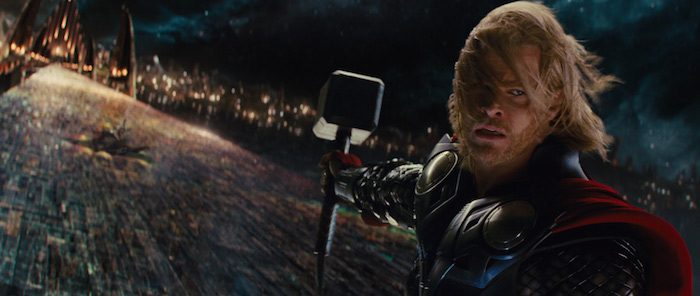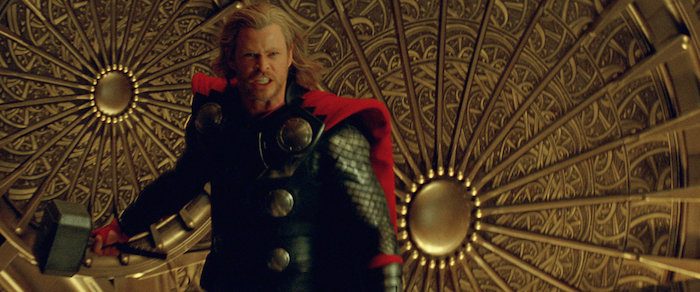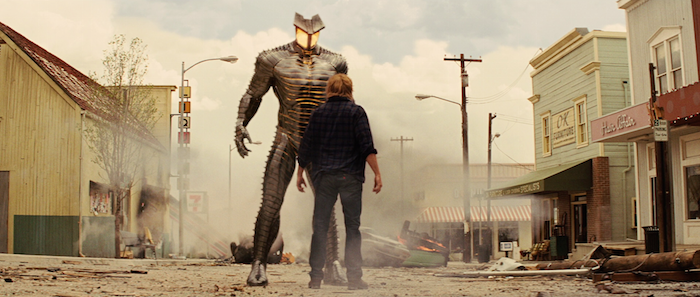Road to Endgame: ‘Thor’ Expands the MCU Using Fantasy, Examinations of Masculinity, and Chris Hemsworth Hotness

(Welcome to Road to Endgame, where we revisit all 22 movies of the Marvel Cinematic Universe and ask, “How did we get here?” In this edition: Thor sets a new tone for the MCU, but continues its muddled approach to warfare.)
After three relatively grounded sci-fi action flicks, the Marvel Cinematic Universe took a leap of faith and ventured into the cosmos. While Iron Man and The Incredible Hulk established the series’ shaky politics, Kenneth Branagh’s Thor redefines the visual and tonal language of the MCU. However, the film still falls back on the major problems of its predecessors, in the way that it frames its conflict.
While messy from a character standpoint, the finished product walks a line that was, at the time, unique in the superhero genre. It straddles two distinct tones that often seem at loggerheads: Earth-bound naturalism, and operatic space-drama. This combination of styles would re-appear in Guardians of the Galaxy, in which they’re married far more smoothly, but their wild clash in Branagh’s Thor feels textually appropriate. It’s what the film is about at its core.

A Bridge Between Worlds
Prior to directing Thor, Kenneth Branagh’s filmography included Twelfth Night, Henry V, Much Ado About Nothing, Hamlet, In the Bleak Midwinter (the story of a man fighting depression by putting on a production of Hamlet), Love’s Labour’s Lost, and As You Like It.
If you count his role as Iago in Oliver Parker’s Othello, that’s as many Shakespeare adaptations as Orson Welles, Akira Kurosawa and Vishal Bhardwaj combined, arguably making Branagh the Bard’s biggest fanboy. He’s exactly who you call to make a grandiose family drama about an aged king, an ambitious prince and the snake in his ear. What makes Thor such an oddity though, is that in addition to being “Shakespeare In Space,” it’s also a fish-out-of-water alien comedy bordering on slapstick.
The majority of the film’s runtime takes place on Earth, where Thor (Chris Hemsworth), the banished God of Thunder, smashes a mug of hot cocoa, walks into a pet store demanding a horse, gets tranquilized in the butt, is tasered by Kat Dennings, and gets hit by a car on more than one occasion. Taika Waititi’s Thor: Ragnarok may have pushed Marvel to its farcical limit, but the seeds for Thor-centric comedy have been in place for quite some time.
A drama about the complications of royal lineage and a comedy about a brutish space oaf in small-town New Mexico ought not to mix. In many ways, they don’t; they may as well be two different films. In dramatizing the divide between them, Marvel also set the stage for The Avengers, in which a scorned space-prince leads an alien army into New York City. However, en route to this major crossover, Thor told a character story that brought humour to the fore, but missed the mark where it mattered.

Thor’s Journey
Thor is a warmonger. He comes from a lineage of warmongers, and despite his father’s shifting attitude towards violent conflict — mere backdrop here, but it’s made to pay off greatly in Thor: Ragnarok — the Asgardian prince seeks out battle against the Frost Giants, for any reason and at any opportunity. During his banishment from the kingdom, he has a change of heart about how best to use his weapons, not unlike Tony Stark in his debut film.
Thor’s newfound humility however, comes not through seeing the ill effects of war, but through experiencing the kindness of others. He is adrift in this new world, unworthy of his hammer and unable to regain his regal identity. This very regality, and all its implications, are called into question when he arrives on Earth, though they never quite factor into Thor’s arc as a character.
Thor’s ascension to the Asgardian throne depends on two things: being his father’s son, and being a fearsome warrior. His conquests involve charging into battle and physically besting his opponents. He even wields a historically phallic symbol — this is how his hammer was depicted in in Norse mythology — without which he’s rendered limp and powerless.
The first battle we see Thor engaged in, with the Frost Giants of Jotunheim, comes not through necessity, but through his desire to dominate an already vulnerable people after having his fears stoked and manipulated. “It’s the only way to ensure the safety of our borders!” he says, of a war his father already fought; a fitting extension of a series already steeped in post-9/11 politics. Though, its resolutions later on leave much to be desired.
As Thor is about to come to his senses and retreat from battle, he’s provoked when one of the Frost Giants refers to him as “princess.” Having his masculinity questioned not only infuriates Thor, but sets the film’s events in motion. His stranger-in-a-strange-land story is just as much about experiencing new cultures and technologies as it is about his relationship to Jane Foster (Natalie Portman), a woman whose point of view the film endorses to a significant degree as it attempts to dismantle Thor’s perspective.
In fact, the first time we ever see Thor on screen, we see him through Jane’s eyes.
Continue Reading Road to Endgame >>
The post Road to Endgame: ‘Thor’ Expands the MCU Using Fantasy, Examinations of Masculinity, and Chris Hemsworth Hotness appeared first on /Film.
from /Film https://ift.tt/2uvSbYr
No comments: